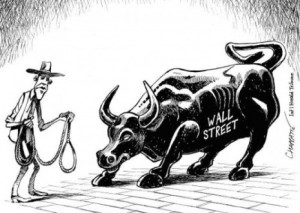October 26, 2015
 If you’ve decided to make contract-for-difference trading your investment strategy of choice, picking out a good trading platform can be tricky. You need to make a well-rounded decision that accounts for more factors than just the commission fees imposed by a given broker. Take a look at the advice XFR Financial Limited gives below to educate yourself on what’s available out there in the CFD trading platforms market.
If you’ve decided to make contract-for-difference trading your investment strategy of choice, picking out a good trading platform can be tricky. You need to make a well-rounded decision that accounts for more factors than just the commission fees imposed by a given broker. Take a look at the advice XFR Financial Limited gives below to educate yourself on what’s available out there in the CFD trading platforms market.
Regulatory Necessities
Before you pick out a trading platform, it’s important that you make sure you’re not engaging in trading behaviour that will have adverse legal consequences. Difference trading is not legal in all countries, and it’s regulated differently in the ones where it is allowed.(CFD trading is particularly heavily-regulated in the United States.) Do a little research to confirm that the CFD platform you’re looking at is fully compliant with the laws of your home country.
CFD Trading Platforms Required Features
As with a lot of products aimed at the small-scale “retail” investor, CFD trading platforms have exploded in popularity in recent years. This has led to a burgeoning market that presents you with a lot of different options. Before you commit to using a particular platform, make sure it offers you the bare necessities you need to make effective trades.
Stability and reliability — in terms of both hardware and software — are extremely important. This will be relatively difficult to judge based on a platform operator’s claims; obviously all of the brokerages offering CFD platforms want to emphasize the reliability of their products. Reading reviews from other traders will give you a better idea of how reliable a platform XFR Financial Limited has actuallyis.
Good platforms need to give you excellent execution control, especially if you plan to concentrate on short-term trading. Look for CFD platforms that feature automated execution, which allows you to complete orders even when trade volume is very high. You’ll also need a full suite of execution features (e.g. boundary setting) to ensure that you retain full control of your trading activity.
Attractive Bonuses At XFR Financial Limited
Even after narrowing your search down to regulatory-compliant brokerages which offer platforms with a decent set of basic features, you’ll still probably have a wide field to choose from. This is when you should look more closely at the extra functions included in various platforms.
Most platforms come with built-in analytic tools like automated charting, risk management functions, and predictive tools. Once again, the actual operators of a platform will tend to state the value of these extras as positively as they can. Look to reviews from past users to get a more realistic sense of how helpful these features can be.
It can take some time to properly evaluate the features of CFD trading platforms and decide whether or not it will make a good fit with your trading strategy. Don’t rush this decision! It can have a profound impact on your overall effectiveness in the difference-trading market. Demo account at XFR Financial Limited will give you a decent feel for how a single trading platform performs, but you need to shop around and consider multiple options before you commit to one and entrust it with your live trades.
Tags:
Business,
Capital,
Currency,
economy,
investments,
money,
stock,
Trading
October 20, 2015
 Sugar is not a grain, or a meat commodity – it is regarded as a soft commodity in much the same way as lumber, cocoa, coffee, orange juice and cotton are. Sugar is primarily traded on the ICE exchange (Intercontinental Exchange) and it has the following ticker symbol: SB. However, sugar is also traded on other exchanges around the world, including the Zhengzou Commodity Exchange (CZCE), the National Commodity Exchange Limited (NCEL), the Brazilian Mercantile and Futures Exchange (BF&M), the National Commodities and Derivatives Exchange (NCDEX), and the Kansai Commodities Exchange (KEX).
Sugar is not a grain, or a meat commodity – it is regarded as a soft commodity in much the same way as lumber, cocoa, coffee, orange juice and cotton are. Sugar is primarily traded on the ICE exchange (Intercontinental Exchange) and it has the following ticker symbol: SB. However, sugar is also traded on other exchanges around the world, including the Zhengzou Commodity Exchange (CZCE), the National Commodity Exchange Limited (NCEL), the Brazilian Mercantile and Futures Exchange (BF&M), the National Commodities and Derivatives Exchange (NCDEX), and the Kansai Commodities Exchange (KEX).
Each contract size for sugar is 50 long tonnes or 112,000 pounds. Sugar is delivered in raw sugar cane with 96° of polarization. Sugar contracts are traded in the following months: January, March, May, July and October from Monday through Friday 2:30 am through 3:15 pm Eastern Standard Time. The price of sugar is quoted at $0.0001 cents per pound, and the tick size is 0.01. Traders must meet specific margin requirements to trade sugar as this determines how much outlay is needed for each contract size.
For example a hypothetical sugar futures contract could take the following format: SB15F@13.12 means that the Sugar Contract for 2015 January is trading at $0.1312 per pound. This is precisely the type of format that a sugar trader would purchase a contract. When you are ready to trade sugar contracts on the ICE, the margin requirement is 12%. In the preceding example, the contract size of 112,000 pounds of sugar would cost a trader $14,672. With a 12% margin upfront, the amount needed to make the trade is $1,760.64.
Understanding How Profits are generated with Sugar
For every $0.0001 move in the price of sugar, the total price move for the contract is $11.20. Profits in sugar contracts are easily determined by the difference between the exit price and the contract price. The result is then simply multiplied by $11.20. Presently, the price of sugar is $11.57. The price of sugar is near its 5 year low figure, since it was trading close to $35 in 2011. The price of sugar has consistently declined over the past five years. Prior to the 2011 sugar price surge, trading sugar was well beneath $30, and in fact between late 2006 and 2008 was hovering around the $10 range.
Sugar is primarily available in the form of honey, Maple syrup, sugar beet and sugar cane. Its distinctive characteristic is that it is sweet and this carbohydrate is an instant pick me up by being able to generate rapid energy for the user. The refined form of sugar is white sugar and it comes from sugar beets and sugar cane. Some 78% of global production in sugar comes from sugar cane. This is why it is imperative to follow news updates regarding weather phenomena that impact upon sugarcane production. Shortages of sugar cane lead to price rises in sugar, depending of course on demand and sugar inventories.
The world’s major producers of sugar include Brazil and India, followed by the European Union. What is particularly interesting about this particular commodity is that the majority of sugar is consumed in the country of its production. This is in stark contrast to many other agricultural commodities such as wheat, corn, soy beans, red meat etc. Many countries export the vast majority of their agricultural produce and soft commodities.
Determinants of the Sugar Price
Depending on which country or region we were talking about, demand for sugar will vary considerably. Western societies are moving away from sugar-saturated diets, in favour of sugar substituted diets. This trend is likely to continue as concerns grow about the impact of consuming too much sugar on the general health and well-being of society.
Sugar substitutes are now widely used across the US and Canada, with Europe close in tow. Some of the most pressing concerns with regards to sugar consumption are obesity, diabetes, tooth decay and the like. Even with declining preferences for sugar, the US remains a major consumer of world sugar.
The price of sugar is not free of market manipulation. In the US and many other countries, there are measures in place to protect producers by maintaining artificially high prices. This has the effect of causing consumers to look at alternatives. For example, many food companies are now turning to corn syrup as a substitute sugar. There are growing calls from sugar beet producers and sugar cane producers for a free-market system vis-a-vis sugar prices.
Of course an important determinant of the price of sugar is the quantity of sugar beets and sugar cane. As mentioned, the more abundant these commodities are, the lower the sugar price will be, all things being equal. Adverse weather has a detrimental effect on the production of these crops. Things like frost damage, excessive rains and flooding, droughts and other negative weather phenomena reduce the crop supply and raise the price of sugar on the markets.
It is clear that tariffs and subsidies are widely used to prop up the sugar markets around the world. Nobody knows quite what the real price of sugar should be, since there is so much artificial maintenance of market prices. In truth, the price of sugar may well be substantially less than what it presently is, but the clearest indicators yet of the price of sugar are likely found in things like export numbers, domestic consumption and society’s changing attitudes towards processed sugar.
Tags:
Business,
Capital,
Commodities,
investments,
money,
stock,
Sugar,
Trading
October 13, 2015
 Take a seat
Take a seat
The stock market can be a confusing place for a newbie. While it’s true that you learn as you go along, you need to come into trading having some basic knowledge of how the market runs and how to play it. At the very least, you should be able to define some common terms so that your investment portfolio manager doesn’t have to speak in a certain way to you…if you get what I mean.
So this is a simple guide into first time investing with all the fancy terminology and great tips. You certainly won’t become a billionaire by sticking to this simple guide but you certainly won’t lose your hard-earned money, and that’s a pretty good deal, right?
Basic terminology
Stocks and funds are not the same thing. A stock is a share in a company that you can buy, hold and sell in the market or privately. A mutual fund consist individual investors buying into different companies together. It is managed by a team of professionals.
If you don’t want to manage your investment, then a mutual fund may be the way to go but then you could also hire a certified financial planner to manage your individual stocks, at a cost of course.
Trading and investing are also slightly different terms. Trading refers to the actual and frequent buying and selling of stocks or funds. Investing, on the other hand, has to do with a long-term approach so the movement of stocks or funds is not as frequent.
Have a plan
No one has money to waste in stocks so you need to have a clear plan going in. You need a CEO and a CFO for the planning and budgeting respectively. This doesn’t mean you should hire people. The point here is to emphasize the need for a vision and a plan as well as a budget and more importantly a reserve fund, in cash, to take care of any emergencies. The reserve fund will help you not have to sell the investment before time, or worse, get into more debt.
Get the capital
Part of plan is to know what you are going to invest i.e. where the cash is coming from. Saving may take too long to make the kind of investment you are thinking about so consider using your 401(K). Most employers have it and it’s pretty easy to have it as your investment capital. Some companies even have ‘classes’ over lunch explaining how it works and would even match your investment dollar for dollar. If you start early, you could have the retirement of your dreams!
Set up a brokerage account
You will need to get a brokerage account with a credible, licensed firm that will conduct your trading and manage your account for you. This is not for free of course, so you will be funding this account. The money will be in the cash portion of the account and used to settle orders. Stocks bought and commissions are debited from this cash, while stocks sold, interest and dividends are credit here as well (which you can withdraw).
Now you’re ready to start the business of buying and selling; and that’s a whole other class. Good luck!
Tags:
Business,
debt,
financial planning,
investments,
money,
stock,
Stock Market
December 16, 2014

Image Source: http://www.ft.com/cms/s/0/14460750-4835-11e3-a3ef-00144feabdc0.html
With the world leaning significantly towards all things tech, technology companies are seeing rapid growth by the minute. In 2013, the US witnessed bulk IPOs from the tech industry, a marked improvement since the temporary dip during the 2009-2010 recession.
Much has been written about who came out as clear winners amongst tech IPOs. But, if you pay less attention to the success stories of individual companies and take a step back, you’ll see how tech companies are taking over the bigger picture.
Out of the 222 companies that went public in 2013, 45 were tech companies.

That said, let’s take a look at why diverting your attention to tech IPOs can prove to be a good idea:
Tech Companies Are Storming The IPO Market
2015 Tech IPO Candidates
| Name |
Funding |
Last Round Date
|
| Uber |
$2.71b |
Dec-14
|
| Cloudera |
$1.20b |
Sep-14
|
| Dropbox |
$1.11b |
Apr-14
|
| Airbnb |
$801.44m |
Apr-14
|
| Box Inc. |
$564.06m |
Jul-14
|
| AppNexus |
$310.50m |
Sep-14
|
| Good Technology |
$291.30m |
Sep-14
|
After Alibaba filed to go public in September 2014, the IPO market saw the technology industry chasing new horizons. The market is now bustling with news from a number of tech enterprises who are positive to go public soon. With leading companies like Palantir, Dropbox, Spotify, Cloudera, Good Technology, Airbnb, and Deem looking to go public in 2015, the technology industry will soon be making waves in the IPO market.
Tech IPOs Are The New Black

The growing need for cloud computing, database management, and software is helping companies build a strong client base. This, coupled with a fast-growing Internet, is sending technology concerns down the IPO road, expanding the market significantly. Add that to the growing dependency of other industries on the technology sector, and you have an exponential growth forecast for tech ventures.
A List Of Startups In The Top IPO List
A number of startups across the US and the rest of the world are rapidly climbing the industry ladder. Companies like Airbnb, Snapchat, and Square are slowly shedding their private skins and taking daring risks by entering the stock market. This can be beneficial to you, because these startups are valued at an average of $5 billion and tend to offer stocks at a relatively low rate.
Successful Tech IPOs In The Past
With Alibaba named the biggest initial public offering in the history of IPOs, the stock market has been showing a favorable inclination towards the tech industry. But, the Chinese e-commerce giant was not the only tech company to launch a grand opening.
Zendesk, a customer service software company, witnessed a swift shift from its initial share price of $9 to $20-$25 in no time. The IPO success story of Twitter is another that has been brewing a new wave of tech IPOs around the world. While all tech companies might not make history, it is pretty evident that tech giants like Alibaba, Twitter, and Facebook have set the ball in motion for technology-based enterprises. The success of these tech giants in the past is a clear indicator why you should pay more attention to existing and upcoming tech IPOs.
If you aren’t convinced yet, consider this tidbit – if you had invested $1000 in the initial public offerings of Amazon, Ebay, Yahoo, Google, Linkedin, and Facebook, this is what you would have made by 2013.

Image Source – http://www.statista.com/chart/1602/internet-ipos/
Don’t miss out on making big bucks on potentially successful tech companies again. Pay close attention to the tech IPOs that are lined up in the near future, analyze the company’s growth, financials, and market strategy. And as always, invest wisely.
Tags:
Business,
economy,
financial planning,
Financial Statistics,
investments,
money,
Profit,
stock
July 28, 2014
 If you’re a movie buff and coincidentally enjoy watching the markets as well, it’s likely you’ve seen the movie Wall Street. The villain, Gordon Gekko, is a fictional stock broker who, while being exceptionally greedy, had a knack for managing investments. Albeit fictional, he became a huge symbol for all the negative aspects of a stock broker.
If you’re a movie buff and coincidentally enjoy watching the markets as well, it’s likely you’ve seen the movie Wall Street. The villain, Gordon Gekko, is a fictional stock broker who, while being exceptionally greedy, had a knack for managing investments. Albeit fictional, he became a huge symbol for all the negative aspects of a stock broker.
Australian Prime Minister, Kevin Rudd, even labeled the perpetrators of the 2008 financial crisis as “Children of Gordon Gekko”. The character is said to be loosely based on a collection of stock broker personalities including Michael Robert Milken who was indicted for racketeering and securities fraud back in the late 80s.
Obviously, this is not how the majority of stock brokers behave, so don’t let this movie skew your perception of the career. Rather, learn the true nature of the profession and gain insights from some of the most successful brokers and hedge fund managers who intend on building positive legacies for themselves. Here are four notable individuals who fit that description:
Chris Gardner
Well known for the movie “The Pursuit of Happyness”, Chris Gardner worked hard at Dean Witter Reynolds as an unpaid intern while homeless and caring for his only son in 1981. They would sleep in bathrooms and church shelters and he would be the first one in and last one out of the office aggressively calling potential clients. He eventually was able to pass the licensing exam necessary to becoming a stock broker. He later left Dean Witter Reynolds to work for Bear Stearns and became one of the top earners of the company. He now owns his own company Gardner Rich & Co LLC and has a net worth of about $60 million.
Ray Dalio
Born in Queens, New York, when he was 12 he bought $300 worth of shares in Northeast Airlines and ended up tripling his investment after the company merged. He earned his BA from Long Island University and his MBA from Harvard. Ray began his career in finance investing in commodity futures on the New York Stock Exchange. He also worked as a futures trader and a broker at Shearson Hayden Stone. He now has a net worth of about $12.5 billion and runs the largest hedge fund firm, Bridgewater Associates. You can find an informative animated video titled “How The Economic Machine Works” on YouTube where he shares his extensive experience of the investment world.
David Tepper
He has been listed by Forbes Magazine as one of the 25 Highest-Earning hedge fund managers in 2013 and earned a whopping 61% return focusing on distressed bonds in 2001. He began his career in finance in the treasury department of Republic Steel in Ohio and later became a credit analyst at Goldman Sachs. The hedge fund firm he leads is Appaloosa Management and has earn substantial returns over the course of its history. In 2012, the firm earned a 30% return because of pinpoint exchanges on certain securities. He has a net worth of about $7 billion and engages in various philanthropic activities mainly in education and hunger. In 2003, he made a considerable $55,000,000 donation to Carnegie Mellon University’s business school. He’s leaving quite a legacy.
Bruce Kovner
This hedge fund manager has been around the block a few times, literally. He became a taxi cab driver at age 31 after quitting his Harvard PhD studies because of writers block. It was then when he decided to engage in derivatives by investing $3,000 from his MasterCard into soybean futures contracts. He didn’t accurately assess the risk of the investment when it grew to $45,000 because he waited till the price dropped to $23,000 before selling. He cites that experience as an important lesson in risk management. He eventually became a trader at Commodities Corporation which is now connected to Goldman Sachs. Currently he’s the chairman of Juilliard where he learned how to play the harpsichord. His net worth is $4.3 billion.
If interested in learning more about a career as a stock broker, visit http://www.stockbrokersalary.biz to read up on informative articles related to the profession. Also, find out how to market yourself as a stock broker to increase your client base.
Tags:
Broker,
economy,
financial planning,
Foreign Exchange,
Funds,
money,
stock,
Trading
 If you’ve decided to make contract-for-difference trading your investment strategy of choice, picking out a good trading platform can be tricky. You need to make a well-rounded decision that accounts for more factors than just the commission fees imposed by a given broker. Take a look at the advice XFR Financial Limited gives below to educate yourself on what’s available out there in the CFD trading platforms market.
If you’ve decided to make contract-for-difference trading your investment strategy of choice, picking out a good trading platform can be tricky. You need to make a well-rounded decision that accounts for more factors than just the commission fees imposed by a given broker. Take a look at the advice XFR Financial Limited gives below to educate yourself on what’s available out there in the CFD trading platforms market.



Recent Comments